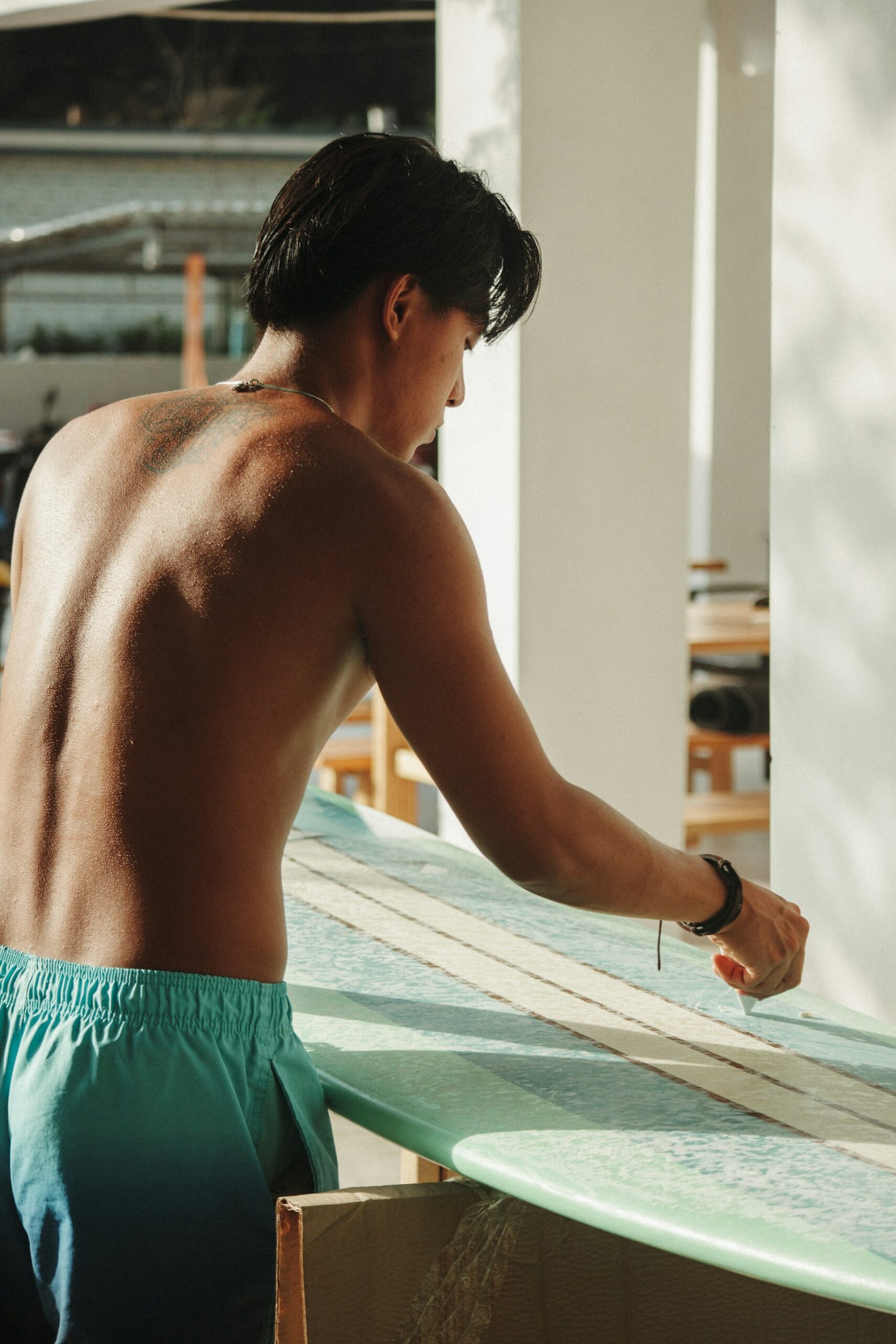To wax a surfboard, clean the surface, apply a basecoat wax evenly, add a topcoat wax for your water temperature, and use a comb to create grip-enhancing bumps.
Surfing requires a waxed board. Without wax, surfers slip off. Wax creates friction between feet and board. It’s like glue for your feet but safe for the ocean. Before you start, know the water temperature.
Cold water needs softer wax; warm water needs harder wax. This guide ensures your board is ready for the waves. Let’s dive in and get your board wave-ready.
Key Takeaways:
- Surfboard waxing ensures a secure grip, enhancing safety while surfing.
- Selecting wax based on water temperature is vital for optimal traction.
- Regular maintenance, including cleaning and reapplying wax, is crucial for a great surf.
How To Wax A Surfboard?
Prepare for an epic surf session! Follow our step-by-step guide to waxing your surfboard for maximum grip and wave-riding fun.
Step 1: Preparing to Wax Your Surfboard
Before you start, know that waxing your surfboard is key. It gives you the grip you need to stay on your board. Let’s get your board ready for the waves.
Role of Surfboard Wax
Surfboard wax stops you from slipping off. It makes the board’s surface rough. This roughness helps your feet stick to the board. No wax means no grip, and no grip means more falls. Wax is a simple way to keep you on your board.
Gathering Your Waxing Supplies
You need the right tools to wax your surfboard. Here’s what to gather:
- A bar of basecoat wax
- A bar of topcoat wax, suited for the water temperature
- A wax comb or scraper
- Clean cloth or paper towels
These items make sure you can wax your board well.
Choosing the Right Wax for Water Temperature
The water you surf in decides the wax you need. Cold water calls for a softer wax. Warm water needs a harder wax. Check the wax label to match it with the water temperature. Using the right wax means better grip and better surf.
Step 2: Cleaning Your Surfboard
A clean surfboard is vital for a good wax job. Dirt or old wax can ruin your grip. Let’s make sure your board is spotless.
Why a Clean Board is Crucial
A clean board ensures the wax sticks well. Dirt or leftover wax can create a smooth spot. These spots make you slip. A clean board means a safe, steady ride.
Step-by-Step Cleaning Process
Here’s how to clean your board right:
- Place your board in the sun for a few minutes. This softens the old wax.
- Use a wax comb or plastic scraper. Gently scrape off the old wax.
- Wipe the board with a clean cloth. Make sure you remove all wax residue.
- For tough spots, use a wax remover. Apply it to a cloth and rub the area until it’s clean.
Now your board is ready for fresh wax.
Step 3: Applying the Base Coat
The base coat is your surfboard’s first defense against slips. It’s the foundation for all the wax layers. Let’s apply a solid base coat.
The Purpose of the Base Coat
The base coat wax grips the topcoat. It makes the topcoat last longer. A strong base means less waxing. It’s the key to a steady ride.
Techniques for Applying the Base Coat
Here’s how to lay down a great base coat:
- Start with a clean, dry board.
- Choose a cool, shaded spot. Direct sunlight can melt the wax.
- Rub the base coat wax on the board. Use firm pressure.
- Move in a pattern. Cover all areas where your feet will go.
- Keep rubbing until you see small bumps. These bumps help your feet grip.
Now your board has a strong base. It’s ready for the topcoat wax.
Step 4: Adding the Top Coat
After the base coat, the top coat wax is what your feet will feel. It’s what keeps you connected to your board in the water.
Selecting Your Top Coat Wax
Choose a top coat wax that suits the sea temperature. Warm water wax is harder; cold water wax is softer. The right choice ensures a better grip.
Application Techniques for Maximum Traction
Apply the top coat with care:
- Use the edge of the wax bar for a thin layer.
- Work in small circles or short strokes.
- Cover the base coat completely.
- Aim for even coverage without excess.
This method ensures a grip that lasts through your surf session.
Creating the Perfect Bumps for Grip
The final step is about texture:
- Look for a light, bumpy texture.
- Use a wax comb if needed.
- Crosshatch patterns work well.
- Aim for uniform bumps across the board.
How to Maintain Your Surfboard Wax?
Maintaining your surfboard wax keeps your rides smooth and your footing sure. Let’s keep that board in top shape.
When to Reapply Your Wax
Reapply top coat wax every few sessions. Look for signs of wear. If the bumps flatten or the board feels slick, it’s time. Regular touch-ups keep the grip just right.
Using a Wax Comb for Traction Maintenance
A wax comb can refresh your wax between sessions. Just comb over the wax to roughen it up. This brings back the texture that helps your feet stick. Use it lightly, and the grip returns.
Full Wax Removal and Reapplication Schedule
Every two to three months, strip and reapply. Start fresh to keep the board’s grip strong. Clean off all the old wax. Then, put on a new base and top coat. This routine will keep your board ready for the waves.
Advanced Waxing Tips and Tricks
Mastering your wax game can lift your surfing. These tips will help you wax smart, not hard.
Waxing for Different Surfing Styles
Your surfing style shapes how you wax. Longboarders might wax the whole deck for footwork. Shortboarders wax where they pop up and stand. Tail pads can replace wax for back foot grip on shortboards. Match your wax area to your style for the best control.
Environmental Considerations and Wax Selection
Think about the environment when choosing wax. Eco-friendly waxes are available. They protect marine life and give you a grip. Also, consider air temperature. It affects how your wax behaves. Warm air can soften wax, so apply it in the shade.
Addressing Common Waxing Mistakes
Avoid these common mistakes:
- Don’t wax a wet board. It won’t stick.
- Don’t use too much wax. It can get slippery.
- Don’t mix different wax types. They may not blend well.
- Don’t forget to dewax regularly. It keeps the board in good condition.
FAQs
Can I use any wax for different water temperatures?
No, use specific wax for different water temperatures. Cold water requires softer wax, while warm water needs harder wax to maintain traction.
What is the best way to remove wax from my surfboard?
The best way to remove wax is to let it soften in the sun, then scrape it off with a wax comb or plastic scraper, and finish by wiping it with a cloth.
Final Words
You know How to Surf, Proper surfboard waxing is more than just a routine; it’s the foundation of an enjoyable surfing experience. With the right wax, technique, and maintenance, you’ll ride the waves smoothly and confidently.
So, keep your board clean, choose the right wax, and remember to refresh it as needed. By doing so, you’ll enhance your grip, your ride, and your overall surf adventures.




